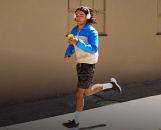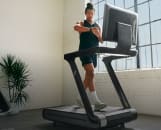
FlamingoImages / iStock / Getty Images Plus via Getty Images
How to Prevent Bonking During Your Next Endurance Run or Ride
Feel like you’re running on empty? Fitness and nutrition experts explain why bonking happens, how to recover, and how to prevent bonking before it happens next time.
By Karla Walsh•
What Is Bonking?
What Does Bonking Feel Like?
What to Do If You Experience Bonking
5 Common Causes of Bonking
How to Prevent Bonking
The Takeaway
Bonking. Many runners, cyclists, and endurance exercisers of all kinds have unfortunately been there, felt that. Sometimes you can feel that dreaded low-energy, feet-dragging feeling coming on. Other times, it hits you quicker than a tidal wave.
But what is bonking, exactly, and why does it happen? We tapped nutrition and fitness experts to decode this common, challenging, yet totally “curable” (and luckily, preventable) condition.
What Is Bonking?
“‘Bonking’ is a mismatch between your energy levels and your exercise intensity,” explains Lt. Col. David Boland, PhD, a US Army physical therapist and the director of the Army-Baylor University Doctor of Physical Therapy Program at Joint Base San Antonio.
If we think of our bodies as cars, we need to fill both of them up with “gas” to fuel them optimally. If you’re preparing to embark on a road trip, it’s wise to stop by a gas station to get a full tank.
“Our muscles hold our bodies’ fuel—carbohydrates—in the form of glycogen. Glycogen gets stored in our muscles, our liver, and then when those are full, we start to put away energy in our fat storage,” explains Washington, D.C.-based registered dietitian Caroline Thomason, RD, reminding us that this is a normal physiological process and not a negative thing.
Our bodies have a limited amount of real estate to store carbohydrates in our muscles and liver. So during exercise, after our bodies burn through the carbs we recently ate for energy (glucose), we’re also torching that limited resource of glycogen (stored carbs).
“Once we’ve used up enough of the glycogen, we experience an intense sensation of not having energy or strength to keep up our activity,” Thomason continues. At this point, you have a few options as you realize you’re running out of gas in the tank: Slow down, refuel (AKA replenish your glucose stores by eating), or both, Boland says.
But you need not hit “E” entirely to feel like you’re bonking, clarifies Elizabeth Shaw, RDN, a registered dietitian nutritionist, founder of Shaw Simple Swaps, and author of the Air Fryer Cookbook for Dummies. “It’s not necessarily true that your glycogen stores have run out completely, but rather, they have exhausted their capacity to generate needed conversion for that period of time, she says. “At this point, you must rely on simple carb intake to complete your workout.”
Keep in mind that glycogen stores vary based on a variety of individual factors, such as body mass, activity level, training status, fueling, pace, and even sleep quality and quantity leading up to the training session, Shaw explains. For this reason, it’s difficult to predict exactly when bonking is likely to come on—or go away.
“What’s most important is learning to know your body and fueling it properly before, during, and after workouts to prevent bonking in the first place,” Shaw says.
Know that you’re not alone if you’ve ever bonked. This is very common among athletes, Boland adds, and it can occur at various times: around mile 20 in a marathon, as you’re conquering your fifth steep hill climb on your bike, or at the tail-end of a 1-mile sprint.
Is Bonking the Same Thing as “Hitting the Wall”?
You might think that “hitting the wall” is the same thing as bonking. To-may-to, to-mah-to, right? Colloquially, sometimes that’s the case, and there’s no standard definition of either term by the American College of Sports Medicine, Shaw notes.
However, you can think of hitting the wall as a mental phenomenon in which you feel daunted by how much of the challenge is left or feel subject to a slew of negative self-talk. Conversely, bonking is a functional depletion of the body’s glycogen (energy) stores, according to Heather Baker, a physical therapist at Endeavor Health Swedish Hospital in Chicago.
If you’re unsure about which sensation you might be experiencing, Shaw suggests tuning into your body. Do you feel physical signs of depleted energy stores, or is this a mental hurdle? Both are challenging in their own way, but bonking has an easy diagnosis: “A person that bonks truly feels awful. It is not simply a mental inability to continue, but a physical block that forces a person to slow, sit, or even lay down,” Baker says.

jacoblund / iStock / Getty Images Plus via Getty Images
What Does Bonking Feel Like?
The following are among the most common short-term symptoms of bonking, the experts we spoke to agree:
Dizziness
Lethargy and fatigue
Shaky hands
Heaviness or cramping in the legs
Hunger
Negative self-talk (bonking can lead to feeling like you’re hitting a wall mentally)
If your body regularly receives inadequate fuel during and after workouts, the long-term symptoms of bonking can escalate to:
Immune system suppression
Hormonal changes
Amenorrhea (menstrual period loss) in women
Muscle loss
A decrease in bone density
Sleep problems
A disruption in training and competing
What to Do If You Experience Bonking
If you recognize yourself starting to slide down a slippery slope to bonk-ville, consume some workout fuel and slow your pace. “If you can up your glycogen before it dips too low, you might be able to turn your body around and avoid a true bonk,” Baker says. But “this all depends on the severity and intensity of the bonk,” she notes.
Simple carbohydrates are your friend mid-workout because they’re easy to digest and can increase energy levels within minutes, Thomason says. If you’re going to do an intense exercise session, Thomason generally recommends that you plan to nosh on a piece of fruit, crackers, pretzels, an energy gel or bites, or jelly beans. Limit protein, fiber, and fat during an endurance workout, as they slow down absorption and prevent energy levels from rising quickly.
If you’re in the middle of a workout rather than a race, it can be wise to press pause, refuel, and resume once your energy levels are closer to “F” than “E,” Shaw adds.
How Long Does Bonking Last?
Remember, glycogen stores vary from person to person, so it’s hard to say exactly how long your bonk will last. Generally, though, the immediate symptoms of bonking should resolve within 10–30 minutes of eating a light snack and, ideally, resting. As long as you eat a well-balanced diet following your workout, muscle glycogen should be fully restored within 24 hours, if not sooner, Boland says.
That said, “the fatigue and lingering symptoms may take a few days,” Baker notes, especially if you’re dangerously close to reaching “empty” on your personal gas tank. “The time to fully recover largely depends on the intensity of the bonk.”
5 Common Causes of Bonking
Now that you know why bonking occurs and what it actually feels like, it’s important to take note of the potential causes of bonking:
1. Not Eating Enough Calories
“The number-one cause of bonking is not adequately fueling with calories for energy,” Thomason says. This could mean not fueling well before your workout, or generally in the context of your entire day.
The US Department of Agriculture’s Dietary Guidelines for Americans provides general calorie intake guidance for different age ranges, sexes, and activity levels, but you can also check in with your doctor or a registered dietitian about how much fuel your body needs specifically.
2. Not Getting Enough Calories from Carbohydrates
If you know you’ve covered your calorie bases, but you’re still bonking, the culprit very well could be not eating enough carbohydrates.
“Carbohydrates are our body’s main fuel source during exercise, so if you’re feeling like you have ‘run out of gas,’ you’re likely needing to increase your carbohydrate consumption before exercise—and possibly during intense activity if it is longer than 30–60 minutes,” Thomason says.
3. Inopportune Meal or Snack Timing
If you think you’re eating enough calories and carbohydrates yet still find yourself bonking fairly often, you may not be eating enough food before, during, or after your workout.
“If you’re going long periods of time between meals and squeezing a workout in, it’s possible that your body is using your glycogen stores for baseline functioning the rest of your day,” Thomason advises. “Then there’s not much left during your workout.”
Exercising in a fasted state—say, as you might if you went out for a run first thing in the morning immediately after waking up—is one of the most common ways to lay the groundwork for bonking, Boland says. (This is especially true if you’re not taking in glucose in the form of an energy gel, drink, or food during exercise.)
4. Inadequate Training or Starting Too Strong
If you’re about to compete in a long race and have yet to run even half the distance in your training program, you might be at risk of bonking, Shaw warns: “Train well to compete well—and prevent bonking.”
Going out of the gates too quickly can also throw off your glycogen game, Boland adds: “Energy expenditure is all about pacing.”
5. An Underlying Health Condition
It’s possible that you may have an underlying condition or issue that’s causing bonking that has nothing to do with your nutrition status, Thomason says. If you’re diabetic, for instance, you may experience an extreme sense of fatigue and low energy if you get low blood sugar during a workout.
If you’ve trained, followed those fueling pointers, and still bonk, consult with your doctor for personalized guidance.
How to Prevent Bonking
You don’t have to stress about how to “fix” bonking if you take measures to prevent it from happening in the first place. The key to doing just that, according to Boland: Learn how hard your body can exercise for a given amount of time or distance, and give yourself enough gas before and along the way.
Here are a few more details on how to prevent bonking:
1. Eat Enough Calories and Carbohydrates
Inadequate fueling, especially when you lack sufficient carbohydrates and calories, can lead to low glycogen stores surprisingly quickly.
Depending on your training regimen, your glycogen stores may never fully “top off,” but they certainly can become “gassed up” again by eating enough nutrient-dense carbohydrates throughout the day. Shaw, a runner herself, swears by potatoes, beans, fruit, and whole grains.
2. Plan Ahead
Especially in the days leading up to an event or an extended training session, focus on your diet and water intake. As we mentioned, it’s crucial to eat enough calories and carbohydrates scattered throughout your meals and snacks. (The National Academy of Sciences generally recommends 45–65 percent of calories from carbs, but that number may change depending on your activity level and what your body needs specifically.)
About 30–60 minutes before your workout, it’s wise to eat about 100 grams of carbohydrates, Boland says, which is about what you’ll find in one medium wheat bagel spread with 2 tablespoons of fruit preserves and a medium apple.
3. Fuel Early and Often
For extended exercise sessions, especially those longer than one hour, continue to fuel throughout the event. Baker generally recommends setting an alarm on your watch or phone to remind you to fuel every 15–30 minutes so you won’t forget. (This tactic can especially come in handy as mental fatigue builds in those later miles.)
“Everyone has different caloric needs, so it might take some experimentation to find your optimal intake,” Baker says. “Write down or develop a plan prior to the event and practice it throughout training. If you’re following a plan and you bonk, you’ll have a better idea about when and how to adjust your intake.”
It’s normal not to feel “hungry” during a grueling workout, but it’s still important to replenish your energy stores. The American College of Sports Medicine recommends consuming 30–60 grams of carbs per hour during exercise that exceeds one hour in length. (For context, a large banana has 31 grams of carbs, four graham crackers have 44 grams, and two slices of wheat bread toast spread with 2 tablespoons peanut butter and drizzled with 1½ tablespoons honey has 61 grams.)
4. Run Your Race
It can feel tempting to try to keep up with others or push for a huge PR, but remember to listen to your body. If you’re struggling to maintain your pace and feel more fatigued than you normally do during training, it can be wise to take your foot off the accelerator a bit, catch your breath, and take a moment to ask yourself, “Am I OK? Could I be bonking, or am I hitting a mental wall?”
5. Stay Hydrated
Some of the symptoms of bonking and dehydration overlap, including fatigue, cramping, and lightheadedness. Take note of how much water you should be drinking each day, and aim to sip around 16–32 ounces of H2O every 30–60 minutes during your workout.
“Depending on the intensity of the activity and how much you’re sweating, you may also want to include an electrolyte source before or during your workout,” Thomason says. “Electrolytes help our muscles function, move fluid into our cells, and replenish any nutrients that we lose through sweating.” (Generally, sports drinks such as Gatorade® or Powerade® all do the trick, notes the National Academy of Sports Medicine.)
The Takeaway
Bonking occurs when your muscles run out of glycogen (aka fuel), forcing you to feel symptoms like fatigue, heavy limbs, dizziness, and hunger. Bonking most commonly occurs in endurance training and racing events such as long-distance running, cycling, or triathlons, although it can happen to fitness folks of all kinds—especially those who don’t consume enough calories or carbohydrates.
Because glycogen stores vary from individual to individual, it’s hard to predict when bonking will start or stop. But in general, immediate symptoms should go away within 30 minutes of resting and fueling up with food and fluids, although lingering symptoms may take a few days to fully recover depending on how much glycogen you depleted, Baker notes.
Everyone’s a little different, so it’s wise to experiment with how much food to eat and when to eat it to discover what works best for your body to avoid bonking—and what the optimal pace, effort, and distance is for your workout. “The key is to know what pace your current fitness level allows you to sustain for the distance you want to go,” Shaw says. “A perfect race would have you running out of glycogen right as you cross the finish line.”

Peloton App
Access thousands of classes with no equipment needed.
This content is for informational and educational purposes only and does not constitute individualized advice. It is not intended to replace professional medical evaluation, diagnosis, or treatment. Seek the advice of your physician for questions you may have regarding your health or a medical condition. If you are having a medical emergency, call your physician or 911 immediately.
This content is for informational and educational purposes only and does not constitute individualized advice. It is not intended to replace professional medical evaluation, diagnosis, or treatment. Seek the advice of your physician for questions you may have regarding your health or a medical condition. If you are having a medical emergency, call your physician or 911 immediately.
Get our latest health stories straight to your inbox
Enter your email to get articles, expert-backed tips, and updates from Peloton sent to your inbox.
By providing your email address, you agree to receive marketing communications from Peloton.
For more about how we use your information, see our Privacy Policy.






